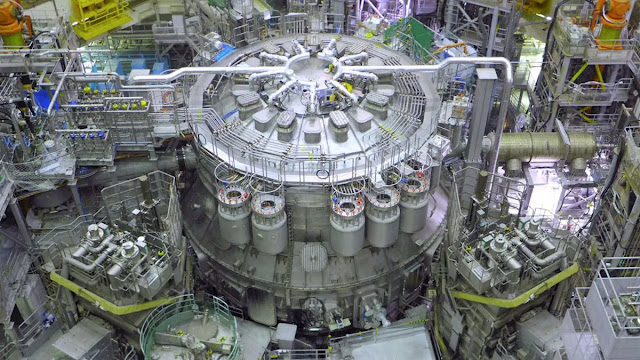Japan’s JT-60SA tokamak will test technologies put to use in ITER
The world's largest and newest fusion reactor fired up last
week, marking a significant milestone in the lengthy journey towards usable
fusion energy. In an effort to induce the fusion of hydrogen nuclei and the
release of energy, Japan's JT-60SA device confines a blazingly hot cloud of
ionised gas, or plasma, inside a doughnut-shaped vacuum vessel using magnetic
fields from superconducting coils. Unlike earlier huge tokamaks, the
four-story-tall device is intended to hold a plasma heated to 200 million
degrees Celsius for roughly 100 seconds.
According to Sam Davis, a project manager at Fusion for
Energy, an EU organisation collaborating with Japan's National Institutes for
Quantum Science and Technology (QST) on JT-60SA and related programmes, last
week's accomplishment "proves to the world that the machine fulfils its
basic function." According to project leader for QST Hiroshi Shirai,
JT-60SA will not generate the durable plasmas required for significant physics
investigations for another two years.
JT-60SA will also support ITER, the massive international
fusion reactor being built in France with the goal of proving that fusion can
produce more energy than it takes to produce it. JT-60SA will test the
technologies and operational expertise that ITER will rely on.
Japan was compensated for agreeing to allow ITER to go to
France by being awarded the right to host JT-60SA and two other modest fusion
research facilities. The arrangement, which was outlined in a 2007 Japan-EU
agreement, called for modernising Japan's ageing JT-60 reactor, which has
served as a mainstay of research since the mid-1980s. While the reactor was
rebuilt from the ground up at an undisclosed cost, the JT-60 building was kept
intact.
JT-60SA, short for "superadvanced," is nearly half
as tall as ITER at 15.5 metres. It has a capacity of 135 cubic metres of
plasma, which is about half the volume of its European counterpart and around
the size of a standard railway tank car. According to Alberto Loarte, head of
ITER's science division, its plasmas will be quite similar to those intended
for ITER and should allow physicists to examine plasma stability and how it
influences fusion power output over long timeframes, offering lessons that can
be applied to the larger tokamak.
JT-60SA has seen major delays that have extended its schedule to more than 15 years, similar to many other fusion programmes. Reactor commissioning was originally scheduled for 2016. Delays were caused by a redesign, problems with procurement, and the Tohoku earthquake in March 2011. Then, in March 2021, when the coils were being tested, a short circuit happened in the wire that was powering one of the superconducting magnetic coils. Traced to insufficient insulation in a critical wiring joint, the short damaged electrical connections and caused a helium leak that would have degraded cooling systems. The incident occurred while there was minimum current in the circuit. Had the current been higher, “damage to the coil could have been severe,” Shirai says. “We were fortunate.” To be safe, the JT-60SA team reworked the insulation in more than 100 electrical connections, a task that took 2.5 years. The accident has led engineers at ITER to plan more careful tests of their coils, too, Shirai says.
